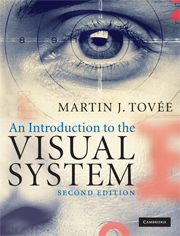Book contents
- Frontmatter
- Contents
- 1 Introduction
- 2 The eye and forming the image
- 3 Retinal colour vision
- 4 The organisation of the visual system
- 5 Primary visual cortex
- 6 Visual development: an activity-dependent process
- 7 Colour constancy
- 8 Object perception and recognition
- 9 Face recognition and interpretation
- 10 Motion perception
- 11 Brain and space
- 12 What is perception?
- References
- Index
- Plate sections
9 - Face recognition and interpretation
Published online by Cambridge University Press: 05 June 2012
- Frontmatter
- Contents
- 1 Introduction
- 2 The eye and forming the image
- 3 Retinal colour vision
- 4 The organisation of the visual system
- 5 Primary visual cortex
- 6 Visual development: an activity-dependent process
- 7 Colour constancy
- 8 Object perception and recognition
- 9 Face recognition and interpretation
- 10 Motion perception
- 11 Brain and space
- 12 What is perception?
- References
- Index
- Plate sections
Summary
What are faces for?
The recognition and interpretation of faces and facially conveyed information are complex, multi-stage processes. A face is capable of signalling a wide range of information. It not only identifies the individual, but also provides information about a person's gender, age, health, mood, feelings, intentions and attentiveness. This information, together with eye contact, facial expression and gestures, is important in the regulation of social interactions. It seems that the recognition of faces and facially conveyed information are separate from the interpretation of this information.
Face recognition
The accurate localisation in humans of the area, or areas, important in the recognition of faces and how it is organised has plagued psychologists and neuroscientists for some years. The loss of the ability to recognise faces (prosopagnosia) has been reported in subjects with damage in the region of the occipito-temporal cortex, but the damage, whether through stroke or head injury, is usually diffuse. The subjects suffer not only from prosopagnosia, but usually from other forms of agnosias too, and often from impaired colour perception (achromatopsia). However, functional imaging has allowed more accurate localisation (see Figure 9.1), and these studies have suggested that the human face recognition system in many ways mirrors that of the non-human primates discussed in the previous chapter. The superior temporal sulcus (STS) in humans (as in monkeys) seems sensitive to the direction of gaze and head angle (cues to the direction of attention) and to movement of the mouth (important for lip reading), as well as to movement of the hands and body (Allison, Puce & McCarthy, 2000).
- Type
- Chapter
- Information
- An Introduction to the Visual System , pp. 133 - 146Publisher: Cambridge University PressPrint publication year: 2008



